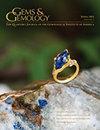Inclusions in Natural, Synthetic, and Treated Ruby
IF 1.6
3区 地球科学
Q2 MINERALOGY
引用次数: 0
Abstract
See end of article for About the Authors. GEMS & GEMOLOGY, Vol. 53, No. 4, pp. 457–458, http://dx.doi.org/10.5741/GEMS.53.4.457 © 2017 Gemological Institute of America been critical to the development of color and clarity treatments (including heating and dyeing, and now more recently introduced processes) and synthetic gems. In the early 1900s, over five million carats of synthetic ruby were produced annually by the flamefusion, or Verneuil, method (Hughes, 2017). Innovative new treatments have also played a major role in satisfying the continued demand for ruby. In the early 1990s, gemological laboratories saw the introduction of chromium-diffused rubies (McClure et al., 1993). In the early 2000s, lead-glass filling of low-quality rubies reached international markets and became one of the most widespread—and most天然、合成和处理红宝石中的内含物
关于作者,请参阅文章末尾。《宝石与宝石学》,第53卷,第4期,第457–458页,http://dx.doi.org/10.5741/GEMS.53.4.457©2017美国宝石研究所对颜色和清晰度处理(包括加热和染色,以及最近引入的工艺)以及合成宝石的开发至关重要。在20世纪初,每年通过火焰熔融法或Verneuil法生产超过500万克拉的合成红宝石(Hughes,2017)。创新的新疗法也在满足红宝石的持续需求方面发挥了重要作用。20世纪90年代初,宝石学实验室发现了铬扩散红宝石(McClure等人,1993年)。在21世纪初,低质量红宝石的铅玻璃填充物进入了国际市场,成为最广泛的——也是最广泛的
本文章由计算机程序翻译,如有差异,请以英文原文为准。
求助全文
约1分钟内获得全文
求助全文
来源期刊

Gems & Gemology
地学-矿物学
CiteScore
2.90
自引率
19.20%
发文量
10
期刊介绍:
G&G publishes original articles on gem materials and research in gemology and related fields. Manuscript topics include, but are not limited to:
Laboratory or field research;
Comprehensive reviews of important topics in the field;
Synthetics, imitations, and treatments;
Trade issues;
Recent discoveries or developments in gemology and related fields (e.g., new instruments or identification techniques, gem minerals for the collector, and lapidary techniques);
Descriptions of notable gem materials and localities;
Jewelry manufacturing arts, historical jewelry, and museum exhibits.
 求助内容:
求助内容: 应助结果提醒方式:
应助结果提醒方式:


